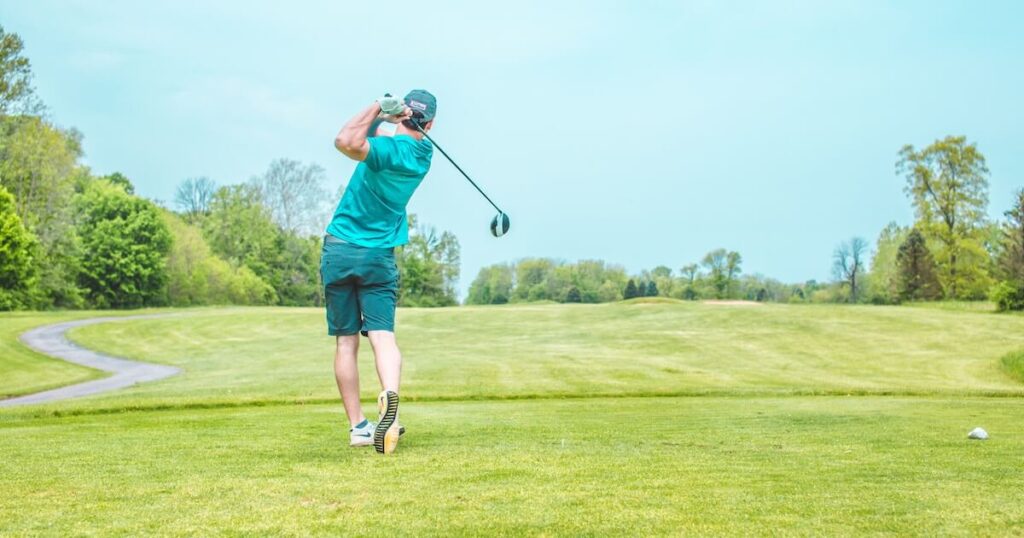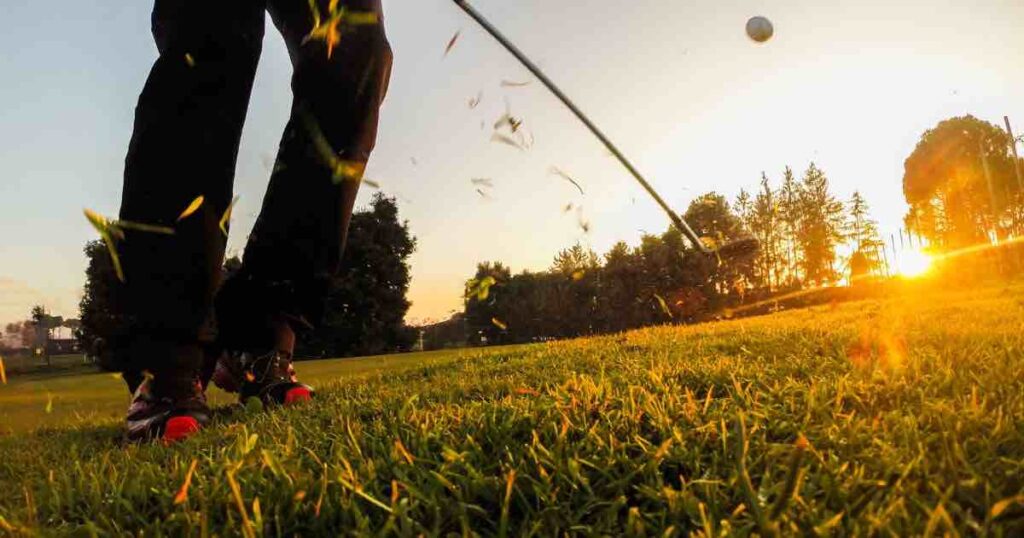The swing is the cornerstone of the game of golf. It’s an intricate combination of power, precision, and control. But the perfect golf swing doesn’t happen overnight. It requires first learning the golf swing stages and the correct golf stance. The key to a sound golf swing is understanding the mechanics of your body and the golf club working together to create an effective strike on the ball. Beyond that, it requires consistent and deliberate practice to refine your swing and build muscle memory. Let’s explore the fundamentals of how to swing a golf club.
The Components of a Golf Swing

Learning how to swing a golf club properly is dependent on understanding a golf swing’s four main components: the Backswing, Downswing, Impact, and Follow-through. We will get into how these work together a bit later on, but first, let’s define them:
Backswing
The backswing is the initial phase of the swing, where you lift the club from its starting position and move it backward until the club is over your head. The goal is to wind your body up like a spring, storing energy you will release later. Remember, a steady and controlled backswing is critical to setting up a successful downswing.
Downswing
Next we have the downswing. This is where the power from your backswing is unleashed. You swing the club forward and downward, shifting your weight from your back to your front foot. It’s important not to rush this process. Smooth and controlled is the name of the game here.
Impact
Impact is the moment of truth in golf. It’s when the clubface makes contact with the ball. A lot hinges on this brief moment. The angle of the clubface, speed of your swing, and point of impact on the ball all contribute to the ball’s direction, distance, and spin.
Follow-through
Lastly, the follow-through is the final part of the swing, where you complete the motion, and the club ends up around your body. This isn’t just a formality. A good follow-through indicates a swing that was in control and well-balanced. It’s also a great way to judge the quality of your swing. It may indicate issues earlier in your swing if you need help to stay balanced during your follow-through.
A golf swing is like a symphony, and each phase plays a crucial role. Practice each component individually, then work on stitching them together into one fluid movement.
How to Grip the Golf Club
Your golf grip plays a pivotal role in your swing. Holding the club correctly will enhance control, increase swing speed, and improve accuracy.
Types of Grips
There are three common types of grips: the interlocking grip, the overlapping grip, and the baseball grip.
- Interlocking Grip: This grip links the left hand’s index finger and the right hand’s little finger (for right-handed golfers). It is often recommended for players with smaller hands, as the interlock can help maintain a firm grip.
- Overlapping Grip: The overlapping grip, also known as the Vardon grip, involves placing the little finger of your right hand on top of the index finger of your left hand. This grip is popular among professional golfers as it balances control and power.
- Ten finger or Baseball Grip: Named after its similarity to how a baseball bat is held, the baseball grip involves holding the club without interlocking or overlapping fingers. This grip is typically recommended for beginners and players with joint concerns, as it is the simplest to master.
Neutral, Strong, and Weak Hand Positioning
Additionally, you might also hear the terms neutral, strong, and weak grips when it comes to holding a club. This isn’t about pressure (more on that below) but about positioning. Understanding the distinction between these is important as you begin to get comfortable with your swing but develop certain ball flight tendencies, such as a hook or a slice.
- Neutral Grip: A neutral grip is when both hands are positioned centrally on the club. The V’s formed by the crease between your thumbs and forefingers of both hands point towards your right shoulder (for right-handed golfers). This grip is ideal for beginners.
- Strong Grip: In a strong grip, your hands turn clockwise on the club (for right-handed golfers). Meaning the V’s formed by the thumb and forefinger point beyond your right shoulder. A strong grip can induce a draw (right-to-left curve for right-handers), but it may also lead to hooks if overdone.
- Weak Grip: When your hands turn counterclockwise on the club (for right-handed golfers), it’s a weak grip. The V’s point towards your chin or left shoulder. This grip can promote a fade (left-to-right curve for right-handers), but too much can cause slices.
Deciding Which Grip to Use
Despite the names suggesting otherwise, no grip is inherently ‘better’ than another; they’re just different ways to hold the golf club. However, for beginners, a neutral grip is recommended. This is because it provides an excellent starting point for understanding the golf swing dynamics without being overly concerned about grip adjustments. As you gain more experience, you might gravitate towards a stronger or weaker grip based on your comfort and swing style.
Achieving the Correct Grip Pressure
Maintaining the proper grip pressure is a delicate balance. While your hold on the club needs to be firm enough to ensure control, it’s important not to grip the club too tightly, as this will inhibit your swing. A common tip is to imagine holding a bird: you want to grasp firmly enough to prevent the bird from flying away but not so tightly as to harm it. That being said, experiment with different pressures to find what feels comfortable and enables a smooth, fluid swing. Remember, practice makes perfect!
Here is a great video from Rick Shiels Golf on how to grip a golf club.
The Proper Golf Stance
The foundation of a good swing lies in adopting the correct golf stance. To achieve this, start by positioning your feet shoulder-width apart, providing a solid base for your swing. Your body should be aligned with the target, with your left shoulder (for right-handed golfers) pointing towards the target. In addition, your weight should be evenly distributed between both feet, maintaining a balance that will allow for a stable, grounded swing.
Bend at your hips, not your waist, keeping your spine straight. Your knees should be slightly bent, mirroring the natural flex of an athletic stance. Your arms should hang down naturally, ensuring a relaxed and comfortable posture. Remember, stiffness can hinder the fluidity of your swing.
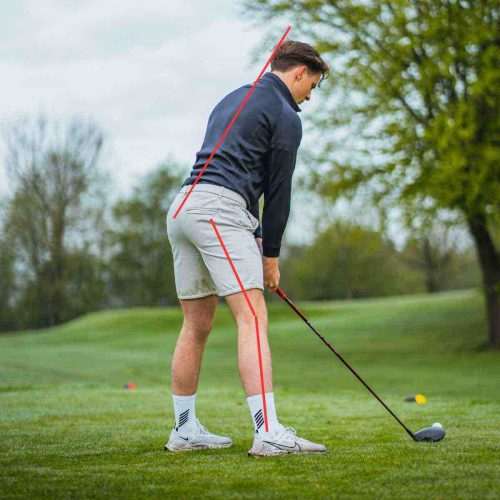
Balance and stability are pivotal to your golf stance. An unstable stance can lead to an inconsistent swing path, resulting in off-target shots. Stability allows for a controlled rotation during the swing, enhancing the precision and power of your shot. Practice your stance until it feels natural and comfortable, and remember that a good stance is the foundation for how to swing a golf club well.
Alignment and Ball Position
Proper alignment and ball position also play a major role in an effective golf swing. When aligning your body, ensure your feet, hips, and shoulders are parallel to where you are aimeing (called the target line). To check alignment, lay a club on the ground pointing at your target, stand parallel to it, and then remove the club. This is a simple yet effective drill to practice alignment.
Furthermore, ball positioning changes depending on the club being used. The ball should be positioned directly in the middle of your stance for short irons. As the club length increases, the ball position should move proportionally towards your left foot (for right-handed golfers). The ball should align with the inside of your left heel for a driver. Understanding and practicing these positions will improve your swing consistency and shot accuracy.
Here’s another great video from US Golf TV on alignment and ball position in your golf stance.
How to Swing a Golf Club
Let’s look at how the four stages work together to create an efficient and smooth golf swing.
Backswing
The backswing sets up the rhythm and lays the foundation for the rest of your swing. As you start your backswing, your arms should remain fairly straight, helping you to create a wide arc. This is called the takeaway. It’s important to keep your left arm (for right-handed golfers) extended and straight as you lift the club. The movement of your arms is linked with the rotation of your shoulders and body, creating a smooth, integrated swing.
As you continue your backswing, the wrist hinge comes into play. Around halfway through the backswing, your wrists should naturally start to hinge, pointing the club upwards and creating what is known as the ‘cocking of the wrists’. This action stores potential energy that will be released in the downswing.
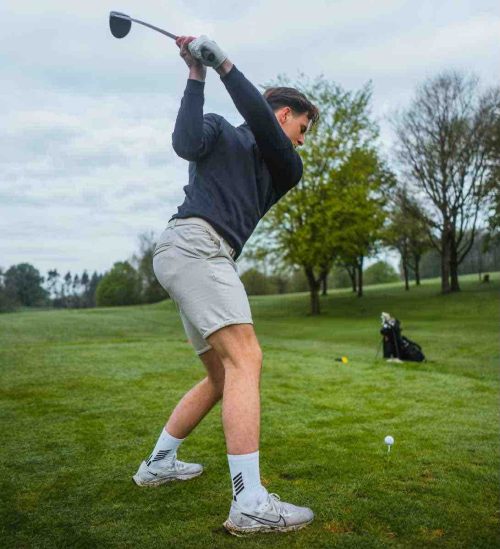
At the top of the backswing, your body should be coiled like a spring, with your weight on the inside of your right foot. The club should be extended back, the shaft parallel to the ground, and the clubhead pointing towards the target. This position signifies that you’re ready to initiate the downswing. Practice this sequence of movements until they feel natural and fluid, as a well-executed backswing sets the stage for a powerful and accurate golf swing.
Downswing
When initiating the downswing, think of your body as a whip, with energy transferring from your lower body to your upper body and finally to the club. As your lower body moves, your hips should uncoil first, followed by your torso, and then your shoulders. Envision your body unwinding sequentially, creating a powerful, fluid motion.
Next, as this unwinding motion commences, your weight should shift from the inside of your right foot (for right-handed golfers) to your left side. Shift your weight smoothly and gradually during the downswing, allowing your body to rotate naturally. Avoid excessive lateral or forward movement that can lead to loss of balance. At this point, your hands and arms should come down, guiding the club toward the ball in a sweeping motion. Again, this is when the ‘cocking of the wrists’ comes into play. Your wrists unhinge, releasing the stored energy and propelling the clubhead toward the ball.
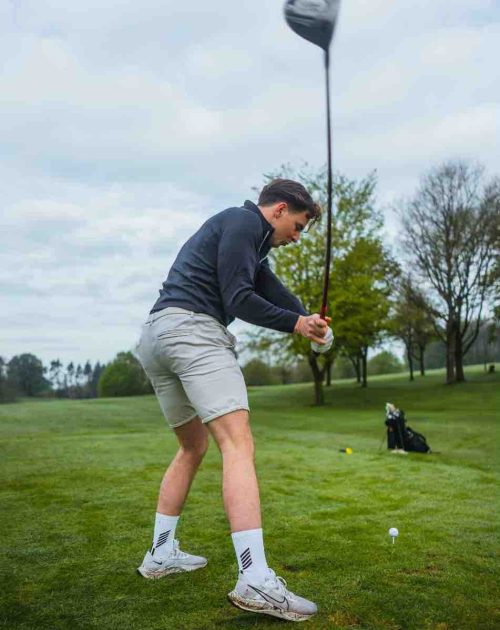
Maintaining the correct sequence in your downswing is essential for accuracy and distance. If your upper body moves before your lower body, it could result in a slice or a hook. Therefore, it’s important not to rush the downswing. Many golfers tend to speed up the swing to hit the ball harder. This often leads to a loss of control and poor shots. Rather, keep the downswing smooth and controlled, letting the built-up energy do the work. The success of your downswing lies in efficiently transferring power and maintaining the correct sequence.
Impact
The impact is the turning point of the golf swing. At this stage, your backswing and downswing motions converge to create your desired shot. Subsequently, your hips should be opening toward the target now. This open positioning allows your body to continue its rotation and carry the clubhead through the swing. Also, the flatness of your left wrist (for right-handed golfers) assures that the clubface is square (perpendicular to the target) at impact, maximizing the chance of a straight shot.
Your hands should be slightly ahead of the clubface at impact, a position often referred to as leading. This creates better ball compression, contributing to distance and accuracy. Lastly, keeping your eyes on the back of the ball is crucial. It ensures you’re not pulling your head up during the swing, which could lead to topping the ball or hitting it off-center. The visual focus helps you maintain the necessary body stillness, leading to improved contact. Remember to hold these positions to increase your chances of a successful shot.
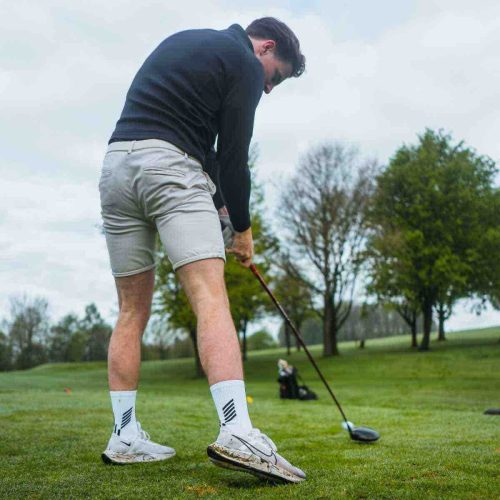
Follow-through
Finally, the often-overlooked follow-through holds immense importance in the golf swing sequence. It culminates all the preceding steps, from the takeaway to the impact. As such, a proper follow-through showcases a golfer’s balance, rhythm, and control.
When you swing your club, aim to end with it over your left shoulder (for right-handed golfers). This motion ensures a full, unrestricted swing while promoting the right degree of rotation. As a result, it helps optimize your shot’s power and trajectory.
A critical aspect of the follow-through is finishing with your body squarely facing the target. This indicates that you’ve successfully rotated your hips and torso through the shot.
Lastly, the weight transfer to your left foot is another fundamental component. A complete weight shift signifies that you’ve maintained balance throughout the swing, a crucial factor in consistently striking the ball well.

Below is another video from Rick Shiels on how to swing a golf club by connecting all these stages together.
Control and Balance:
Maintaining control and balance throughout the swing is essential. Try to keep your movements steady and smooth. Otherwise, too much speed will upset the timing of your rotation and lead to a loss of power and errant shots. Here are some tips on how to swing a golf club with control:
- Stable Lower Body: Keeping a stable lower body during the swing helps maintain control and balance. Avoid swaying or sliding excessively during the backswing and downswing. Instead, focus on maintaining a solid base by engaging the core muscles and planting the feet firmly on the ground.
- Maintain Posture: Correct posture is vital for balance and control throughout the swing. Keep a slight knee flex, a straight spine, and a neutral head position. Avoid slouching or standing too upright, as it can affect your ability to rotate properly and remain stable.
- Keep a Smooth Rhythm: A well-paced swing promotes fluidity, ensuring every part of your body works in harmony, from the backswing to the follow-through. Conversely, a hasty swing might compromise your stance and balance, leading to inaccurate shots. Slow, steady, and rhythmic swings will enhance precision and control. Practicing at a consistent speed helps engrain this rhythm into your muscle memory, resulting in a more reliable and balanced swing.
Practice and Consistency
Developing a good golf swing is not achieved overnight. It requires regular practice. By dedicating time to learn how to swing a golf club and refine your technique, you can improve your swing and your shot performance on the course. Here are some suggestions for drills and exercises that can help you:
Practice Swings
One of the most fundamental aspects of improving your golf swing is practicing without hitting a ball. By focusing solely on the motion and mechanics of your swing, you can refine your technique and make necessary adjustments. Hence, practice swings allow you to work on your grip, posture, alignment, and tempo without the added pressure of hitting a ball.
Mirror Work
Likewise, utilizing a mirror during practice sessions can provide valuable feedback on your swing mechanics. Stand in front of a mirror and observe your posture, backswing, downswing, and follow-through. This visual feedback helps you identify any flaws or areas that need improvement.
Video Analysis
Filming and analyzing your golf swing can provide valuable insights into your technique. Whether it’s via an app on your phone or tablet, or a camera equipped golf launch monitor, reviewing the footage lets you identify any flaws or inconsistencies in your swing mechanics. Subsequently, this allows you to make targeted adjustments and track your progress over time.
Swing Drills
Additionally, you can incorporate specific drills into your practice to get comfortable with your swing. These drills allow you to focus on each part, from the backswing to the follow-through. Below are some examples of swing drills:
One-Handed Drill
This enhances your control over the clubface and improves your balance. To perform this drill, grip your golf club with only one hand—your trailing hand first, then repeat with your leading hand. Swing the club slowly and deliberately, maintaining balance and control throughout the swing. This drill will help you understand each hand’s role in the swing and can improve your clubface control.
Pause at the Top Drill
This drill focuses on improving your swing’s rhythm and tempo. Start your backswing as usual, but pause briefly when the club reaches the top of the swing. This pause helps you set the club correctly and instills a smooth rhythm, preventing rushing the downswing. As a result, it’s a valuable drill for those needing help with timing or those who tend to swing too quickly.
Half-Swing Drill
This drill helps improve control and accuracy. Start by addressing the ball as usual, but restrict your backswing to a half-swing instead of swinging fully. This limited swing forces you to concentrate on the basics: alignment, grip, and posture. It also encourages a smooth, controlled swing rather than a rushed, forceful one.
Feet-Together Drill
This drill is all about balance. Stand with your feet together, holding the club as you normally would. Next, execute your swing, maintaining your balance throughout. This drill reveals if you tend to swing too hard or lose your balance, which can negatively impact your swing.
Remember, consistency is what leads to results. Set aside regular practice sessions and stick to a routine that works for you. Whether it’s hitting the driving range, practicing at home, or working with a golf instructor – consistent practice will develop muscle memory and establish a solid golf swing.
Final Thoughts
To conclude, knowing how to swing a golf club requires understanding and implementing a few fundamental principles. First, your golf stance is crucial. Second, grip the club firmly, but don’t squeeze it. Third, remember the stages of a swing and that the power comes from your body, not your arms. Your hips and shoulders should rotate while your arms guide the club.
Just as important as these technical aspects is your mindset. Developing and improving your golf swing requires time and effort. Take it step by step, maintaining patience with the process. When you’re ready, think about investing in a decent set of high performing beginner golf clubs, and continue to improve your mechanics. Even the best golfers continually work on their swings, so keep a positive and resilient attitude, and the results will follow.
If you’re a beginner golfer, you may also be interested in our Best Golf Balls for High Handicappers Guide.

